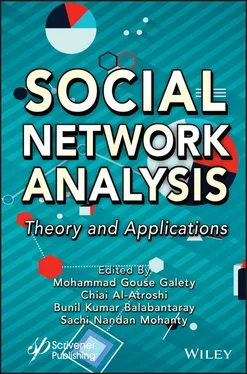Social Network Analysis
Здесь есть возможность читать онлайн «Social Network Analysis» — ознакомительный отрывок электронной книги совершенно бесплатно, а после прочтения отрывка купить полную версию. В некоторых случаях можно слушать аудио, скачать через торрент в формате fb2 и присутствует краткое содержание. Жанр: unrecognised, на английском языке. Описание произведения, (предисловие) а так же отзывы посетителей доступны на портале библиотеки ЛибКат.
- Название:Social Network Analysis
- Автор:
- Жанр:
- Год:неизвестен
- ISBN:нет данных
- Рейтинг книги:4 / 5. Голосов: 1
-
Избранное:Добавить в избранное
- Отзывы:
-
Ваша оценка:
- 80
- 1
- 2
- 3
- 4
- 5
Social Network Analysis: краткое содержание, описание и аннотация
Предлагаем к чтению аннотацию, описание, краткое содержание или предисловие (зависит от того, что написал сам автор книги «Social Network Analysis»). Если вы не нашли необходимую информацию о книге — напишите в комментариях, мы постараемся отыскать её.
As social media dominates our lives in increasing intensity, the need for developers to understand the theory and applications is ongoing as well. This book serves that purpose.
Audience
Social Network Analysis — читать онлайн ознакомительный отрывок
Ниже представлен текст книги, разбитый по страницам. Система сохранения места последней прочитанной страницы, позволяет с удобством читать онлайн бесплатно книгу «Social Network Analysis», без необходимости каждый раз заново искать на чём Вы остановились. Поставьте закладку, и сможете в любой момент перейти на страницу, на которой закончили чтение.
Интервал:
Закладка:
21. Gunawan, T.S., Abdullah, N.A.J., Kartiwi, M., Ihsanto, E., Social network analysis using python data mining, in: Proceedings of 8th International Conference on Cyber and IT Service Management (CITSM) , pp. 1–6, 2020.
22. Viard, T., Latapy, M., Magnien, C., Computing maximal cliques in link streams. Theor. Comput. Sci ., 609, 245–252, 2016.
23. Housley, W., Procter, R., Edwards, A., Burnap, P., Williams, M., Sloan, L., Rana, O., Morgan, J., Voss, A., Greenhill, A., Big and broad social data and the sociological imagination: A collaborative response. Big Data Soc ., 1, 2, 2053951714545135, 2014.
24. Casteigts, A., Flocchini, P., Quattrociocchi, W., Santoro, N., Time-varying graphs and dynamic networks, Int. J. Parallel Emergent Distrib. Syst ., 27, 5, 387–408, 2012.
25. Ackland, R. and Zhu, J.J., Social network analysis, in: Innovations in Digital Research Methods , pp. 221–244, 2015.
26. Goldenberg, D., Social Network Analysis: From Graph Theory to Applications with Python . PyCon’19. arXiv preprint arXiv: 2102.10014, 2021
27. Sahneh, F.D., Vajdi, A., Shakeri, H., Fan, F., and Scoglio, C., GEMFsim: A stochastic simulator for the generalized epidemic modeling framework. J. Comput. Sci ., 22, 36–44, 2017.
28. Van den Broeck, W., Gioannini, C., Gonçalves, B., Quaggiotto, M., Colizza, V., Vespignani, A., The GLEaMviz computational tool, a publicly available software to explore realistic epidemic spreading scenarios at the global scale. BMC Infect. Dis ., 11, 1, 1–14, 2011.
29. Wilensky, U. and Tisue, S., Netlogo: A simple environment for modeling complexity, in: Proceedings of International conference on complex systems , vol. 21, pp. 16–21, 2004.
30. Chao, D.L., Halloran, M.E., Obenchain, V.J., Longini Jr., I.M., FluTE, a publicly available stochastic influenza epidemic simulation model. PloS Comput. Biol ., 6, 1, e1000656, 2010.
31. Word, D.P., Abbott, G.H., Cummings, D., Laird, C.D., Estimating seasonal drivers in childhood infectious diseases with continuous time and discrete-time models. Proceedings of the American Control Conference , pp. 5137–5142, 20102010.
32. Zafarani, R., Abbasi, M., & Liu, H., Social media mining: An introduction. Cambridge: Cambridge University Press, 2014.
33. Sahu, B.P., Gouse, M., Pattnaik, C.R., Mohanty, S.N., MMFA-SVM: New bio-marker gene discovery algorithms for cancer gene expression. Materials Today: Proceedings , 2021, https://doi.org/10.1016/j.matpr.2020.11.617.
34. Arulkumar, N., Galety, M.G., Manimaran, A., CPAODV: Classifying and assigning 3 level preference to the nodes in VANET using AODV based CBAODV algorithm, in: Intelligent Computing Paradigm and Cutting-edge Technologies. ICICCT 2019. Learning and Analytics in Intelligent Systems , L. Jain, S.L. Peng, B. Alhadidi, S. Pal (Eds.), Springer, Cham, 2020, vol. 9, https://doi.org/10.1007/978-3-030-38501-9_42.
* Corresponding author : abhishek.dilip.bhambere@gmail.com
2
Introduction To Python for Social Network Analysis
Agathiya Raja1*, Gavaskar Kanagaraj1 and Mohammad Gouse Galety2
1 Computer Science, Technical University of Clausthal, Clausthal-Zellerfeld, Germany
2 Department of Information Technology, Catholic University in Erbil, Erbil, Iraq
Abstract
A social network is an architecture that consists of the communication among actors, which holds further information about their details and relationship with one another. They are interconnected in the form of edges (or link) and nodes (or vertices). Every social network has its purposes like education, business, consulting, and so on. Social networking platforms play an ever-increasing vital role in almost every field of daily life, including past predictions to future technologies. The intense use of social networking platforms provides a good understanding overview of the community and social behavior. However, well-known projections and conclusions based on analyzing social networking platforms tend to be inexact. A study or analysis on the social network is helpful in many ways (e.g., to find the criminal). Using network-level analysis, one could isolate an objective component/node in a network. One could identify the core, density. One could compute the shortest path, reciprocity, and even homophily. There are incompatible properties among the networks and the network resemblance or connection between multiple networks. Analyzing and visualizing the network using Python offer good insights about the networks to end-users. A high-level programming language provides significant advantages for the end-users and tender vast library packages for integration. Python is an uncomplicated interpreter language, and it is fast to prototype. The language is proposed with several algorithms, which are used to analyze the complex graph. It is incorporated with many packages and libraries, each possessed to perform the desired methodology. The chapter explains the installation and working environment of Python.
Keywords: Python, social network analysis, Network-X, graph, nevaal
2.1 Introduction
A social network is an architecture that consists of the communication among actors, which holds further information about their details and relationship with one another. They are interconnected in the form of edges (or links) and nodes (or vertices). Every social network has its purposes, like education, business, consulting, and so on. Social networking platforms play an ever-increasing vital role in almost every field of daily life, including past predictions to future technologies. The intense use of social networking platforms provides a good understanding overview of the community and social behavior. However, well-known projections and conclusions based on analyzing social networking platforms tend to be inexact.
A study or analysis on the social network is helpful in many ways (e.g., to find the criminal). Using network-level analysis, one could isolate an objective component/node in a network. One could identify the core, density. One could compute the shortest path, reciprocity, and even homophily. There are incompatible properties among the networks and the network resemblance or connection between multiple networks.
Analyzing and visualizing the network using Python offers good insights about the networks to end-users. A high-level programming language provides significant advantages for the end-users and tender vast library packages for integration. Python is an uncomplicated interpreter language, and it is fast to prototype. The language is proposed with several algorithms which are used to analyze the complex graph. It is incorporated with many packages and libraries, each possessed to perform the desired methodology. This chapter explains the installation and working environment of Python.
NetworkX is one of the most efficient software packages and an open-source tool in Python. It is mainly used to analyze the complex graph database by manipulating the larger data sets. The chapter explains more about the importance of using Python with desired examples. The installation setup and working environment have been clearly explained in this chapter for better understanding. Although NetworkX is not ideal for large-scale problems with fast-processing requirements, it is an excellent option for real-world network analysis, standard graph algorithms. It is optimum for denoting networks of different types, like classic graphs, random graphs, and artificial networks. Thus, it takes advantage of Python’s ability to import data from external sources. The package NetworkX consists of many functions of graph generators and facilities to manipulate (read and write) the graphs in so many formats, such as .edgelist, .adjlist, .gml, .graphml, .pajek, and so on.
Читать дальшеИнтервал:
Закладка:
Похожие книги на «Social Network Analysis»
Представляем Вашему вниманию похожие книги на «Social Network Analysis» списком для выбора. Мы отобрали схожую по названию и смыслу литературу в надежде предоставить читателям больше вариантов отыскать новые, интересные, ещё непрочитанные произведения.
Обсуждение, отзывы о книге «Social Network Analysis» и просто собственные мнения читателей. Оставьте ваши комментарии, напишите, что Вы думаете о произведении, его смысле или главных героях. Укажите что конкретно понравилось, а что нет, и почему Вы так считаете.












